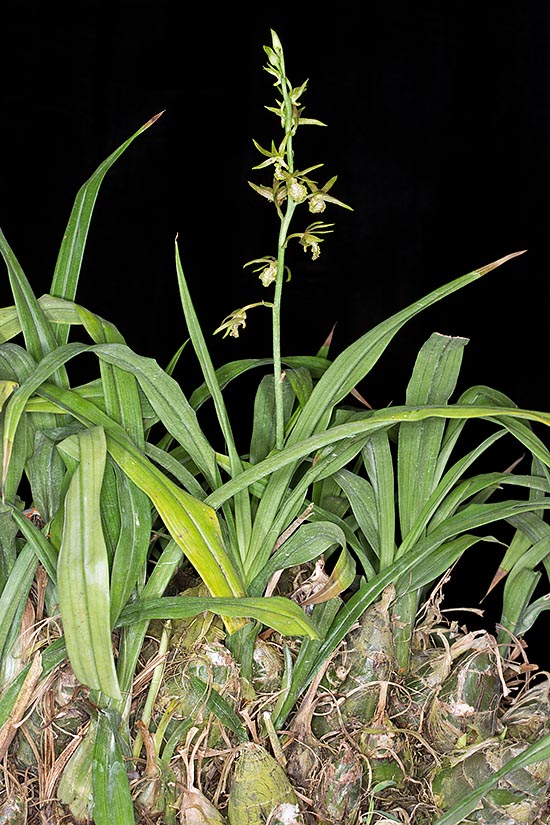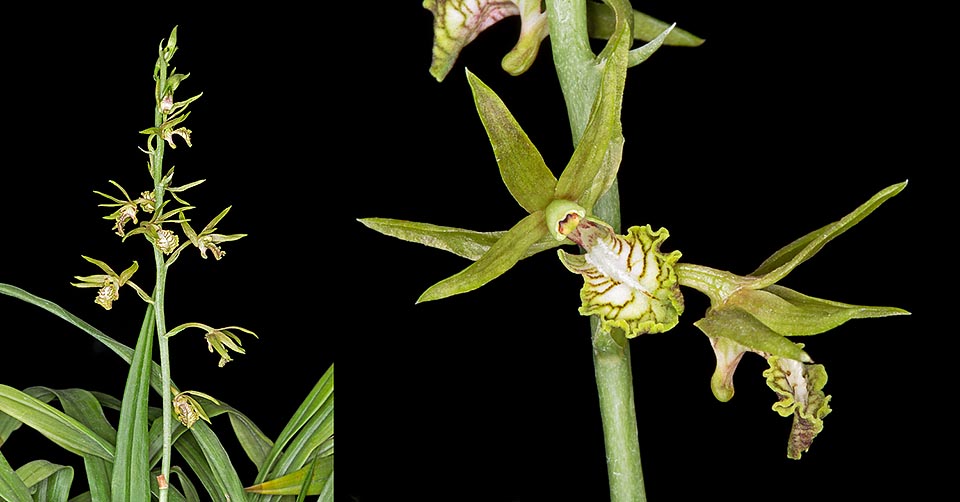Family : Orchidaceae

Text © Pietro Puccio

English translation by Mario Beltramini

Eulophia andamanensis is a deciduous terrestrial species with almost conical pseudobulbs, up to about 10 cm long, with 5-6 oblong-lanceolate, 20-40 cm long and 1-4 cm broad leaves © Mazza
The name of the genus is formed by the Greek prefix “εὖ” (eu) = well and by the substantive “λόφος” (lophos) = height with reference to the crests present on the labellum; the Latin name of the species refers to one of its origin countries, the Andaman Islands.
Common names: green orchid (English); lan luân anđaman (Vietnamese).
The Eulophia andamanensis Rchb.f. (1872) is a deciduous terrestrial species with almost conical pseudobulbs, up to about 10 cm long, with 5-6 oblong-lanceolate leaves with pointed apex, 20-40 cm long and 1-4 cm broad, of intense green colour. Racemose inflorescences, on 20-30 cm long scape, from the base of the pseudobulbs, erect, 8-35 cm long, carrying 10-15 flowers of about 2,6 cm of diameter with triangular sepals, about 1,4 cm long and 0,4 cm broad, of green colour, petals slightly smaller than the sepals and of the same colour and trilobed, about 1,2 cm long, labellum with green lateral lobes and whitish median lobe with brown venations and green creped margins, run at the base by three white crests.
It reproduces by seed, in vitro, but usually and easily by division, to be done at the vegetative restart, with each section provided of at least 2-3 pseudobulbs.
Species diffused in the wild, but rarely present in the collections, with tiny flowers having a particular color and long lasting, about 4-6 weeks, of easy cultivation, can grow in open air in the tropical and subtropical zones and, marginally, in sheltered position, in the temperate-warm ones where temperatures under the 10 °C are exceptional events and of short duration, finally is not particular about the soil, provided well drained.
The waterings must be regular and abundant during the growth phase, but allowing the loam to dry up before giving water again, being the roots sensible to the water stagnations, then practically suspended until the vegetative restart, but without wrinkling the pseudobulbs too much, this period of rest is necessary for a good blooming.
Where the climate does not allow the permanence in open air in all seasons, it may be cultivated in pot, utilizing perfectly draining loam rich of organic substance, in order to be sheltered during the coldest months in luminous ambient with temperatures of 18-30 °C, with lowest night values, during the resting period, not under the 14 °C.

Native to Cambodia, Andaman Islands, Nicobar Islands, Laos, Peninsular Malaysia, Singapore, Sumatra, Thailand and Vietnam, is rarely present in the collections. The racemose, erect, 8 to 35 cm long inflorescences, carry about 10-15 flowers of 2,6 cm of diameter. It is easy to cultivate where the climate permits © Giuseppe Mazza
The species is reported in the appendix II of the CITES (species whose trade is internationally ruled).
Synonyms: Graphorkis andamanensis (Rchb.f.) Kuntze (1891); Cyrtopera andamanensis (Rchb.f.) Rolfe (1895); Eulophia keithii Ridl. (1896); Eulophia poilanei Gagnep. (1931).
→ For general notions about ORCHIDACEAE please click here.
